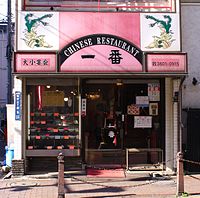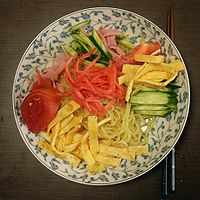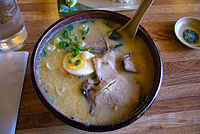- Japanese Chinese cuisine
-

This article is part of the series Chinese cuisine Regional cuisinesFour Great Traditions
Cantonese • Huaiyang • Shandong • Sichuan
Eight Great Traditions
Anhui • Cantonese • Fujian • Hunan • Jiangsu • Shandong • Sichuan • ZhejiangBeijing and the vicinity
Beijing • Imperial • Aristocrat • TianjinOther regional styles
Chaozhou • Guizhou • Hainan • Hakka • Henan • Hong Kong • Hubei • Jiangxi • Macanese • Manchu • Northeastern • Shaanxi • Shanghai • Shanxi • Taiwanese • Xinjiang • Tibetan (Xizang) • YunnanReligious cuisinesBuddhist • IslamicIngredients and types of food China portal
China portalJapanese Chinese cuisine is a unique style of Chinese cuisine served by Chinese restaurants in Japan. Many of these restaurants are Japanese-owned, though there are some which are operated by overseas Chinese. Chūka (中華, short for 中華料理 chūka ryōri, literally "Chinese food") is the adjective for Japanese style "Chinese" dishes, or the restaurants in Japan which serve them.
Contents
Overview
Chuka dishes originated in China, but have become modified over the years to suit Japanese taste, often with Japanese or even Western foods. They have changed enough that they are not identified as Chinese dishes by the Chinese themselves, nor as Japanese dishes by the Japanese. Japanese mistakenly consider them "Chinese", though the dish of origin in any Chinese restaurant would never be made in this way. In some cases, Japanese foods have been added, such as in the case of miso-ramen. In other cases, only the noodles are "Chinese", as in the case of hiyashi chūka, which was invented in Sendai in 1937, and uses Western food influences such as sliced cured ham. As meat (other than fish) was not common in Japanese cooking until recently, many meat dishes, particularly pork dishes, are of Chinese origin or influence.
Though formerly Chinese cuisine would have been primarily available in Chinatowns such as those in port cities of Kobe, Nagasaki, or Yokohama, and a number of the dishes are considered meibutsu (regional specialties) of these cities, Japanese-style Chinese cuisine is now commonly available all over Japan. As Japanese restaurants are often specialized to offer only one sort of dish, cuisine is focused primarily on dishes found within three distinct types of restaurants: Ramen restaurants, Dim sum houses, and standard Chinese-style restaurants.
Ramen
Ramen (ラーメン) a dish of noodles in broth, usually with various meat and vegetable toppings, is also often referred to as Chuka Soba (中華そば, lit. "Chinese noodles.") In Japan, ramen is currently one of the most popular fast-food options. Though every Japanese city has numerous inexpensive ramen restaurants specializing in these noodles, countless varieties of instant ramen (much like the Japanese equivalent of the frozen TV dinner) are also available. These noodles have changed much since their origin in China. Four main types of ramen are widely available in Japan: shio ("salt), shoyu ("soy sauce"), tonkotsu ("pork bone") and miso ("soy-bean paste"). While the toppings used in ramen are generalized based on the broth type, this can also vary from shop to shop. As complements to the noodles, ramen restaurants also commonly offer Japanese-style Fried Rice and Gyoza (Pan-Fried Dumplings).
Dim Sum in Japan
Dim sum (点心 tenshin or 飲茶 yamucha in Japanese) in Japan is often very different from that which has been popularized in Chinatowns in the United States and Canada. In Japan's Chinatown areas, restaurants in which numerous dishes are brought around to diner's tables on carts do exist. But, in general, Dim sum items have only recently begun to gain popularity around Japan. Instead of carrying full menus of authentic, Chinese-oriented items such as stewed chicken's feet or tripe, Japanese dim sum restaurants, now found in larger cities such as Osaka and Tokyo seem to promote a cafe-like atmosphere. At these cafes, tea and snacks often become the focus, instead of full meals. In general, the menus seem to focus on cafe items, such as Shumai (minced pork or shrimp dumplings,) sho lon po (steamed dumplings with juicy meat inside) and the like. These are usually served alongside of pots of oolong or jasmine tea.
Chinese restaurants in Japan
 A Chinese restaurant in Katsushika, Tokyo.
A Chinese restaurant in Katsushika, Tokyo.
Chinese Restaurants, (中華料理屋/chūka ryōriya or 中華飯店/chūka hanten) serve a distinct set of popular dishes that are not necessarily typical of authentic Chinese cuisine. They also cater to Japanese tastes. Currently, most towns in Japan have at least one Chinese eatery, as the cuisine is very popular. There are also many packaged sauces available to easily cook favorite Chinese-Japanese dishes right at home. Some of these typical dishes are:
- Mābō-dōfu (麻婆豆腐) are Stir fried dishes of ground pork mixture with Tofu cubes (mābō-dōfu) in a slightly spicy sauce.
- Mābō-nasu (麻婆茄子) are Stir fried dishes of ground pork with Eggplant (mābō-chezu) in a slightly spicy sauce. The dish was popularized in Japan by Chen Kenmin in 1952.
- Chin-jao Rōsu (青椒牛肉; also called pepper steak) is a stir-fry of thinly sliced Beef strips with Japanese green peppers and often bean sprouts in a Oyster sauce. This dish is popularized in the Japanese anime Cowboy Bebop.
- Subuta (酢豚) is the Japanese take on Sweet and sour pork. It usually has a thicker, amber-colored sauce, unlike the caustic orange or red of the Americanized version. Also unlike the American version, it does not typically contain pineapple. Another common dish substitutes the fried pork in this dish with small fried meat-balls, called "niku-dango".
- Shabu-shabu (しゃぶしゃぶ) is a Japanese variant of the Chinese hot pot known as "shuan yang rou". The dipping sauce of goma (sesame seed) was also adopted from the Chinese.
- Ebi no Chili Sauce (えびのチリソース) is a spicy, thick-sauced shrimp dish. As the name suggests, chili sauce is used.
- Kara-age (唐揚, lit. Tang (as in the Chinese Dynasty) Fry) are bite-sized pieces of chicken thigh, dipped in a thick batter and fried. Usually, it is served without sauce. Some restaurants serve this with a salt and pepper mixture on the side for dipping, and some recipes call for a mixture of soy sauce, vinegar and scallions similar to that used on dumplings.
- Buta no Kakuni (豚の角煮) is thick slices of pork bellies stewed in a soy sauce based mixture, often served with Shanghai bok choi and Chinese mustard.
- Hoi Kō Rō (回鍋肉) is a stir-fry of thinly sliced pork and cabbage in a miso-based sauce.
- Banbanji (棒棒鶏) is a cold dish of steamed chicken which is shredded and covered in a sesame sauce. It is often accompanied by cold vegetables as a salad or appetizer.
- Harumaki (春巻き, lit. "Spring Rolls") are very similar to those found in Americanized Chinese restaurants, with a thin wrapper and vegetables inside.
- Kani-tama (かに玉 or 蟹玉) is very similar to the Americanized Egg foo young, but exclusively using crabmeat as the filling. It is served in a thick, brownish sauce, like its American counterpart.
- Champon (ちゃんぽん) is a ramen-like dish, topped with fried pork, seafood, and vegetables
- Gyōza (餃子 or ギョーザ), as mentioned before, are a very popular dish in Japan. Most often, they are seen in their pan-fried form, but they can be served boiled as dumplings or even deep fried, as well.
- Chāhan (炒飯 or チャーハン) is sometimes called "yakimeshi," literally meaning Fried rice. It is very different from fried rice found in American Chinese or authentic Chinese restaurants, as it uses Japanese short-grain rice, which generally has a stickier consistency than that used in other countries. Additionally, though there are many different recipes using such diverse ingredients as Welsh onion ground pork, crab, bamboo shoots, the classic Japanese fried rice does not use soy sauce, remaining white when served. It typically uses egg, green peas, and thinly sliced ham.
See also
External links
- Ohtaya's Real Chinese Recipes for Home (Japanese) - Full of both standard and obscure Japanese-Chinese recipes, including tips on gyoza and spring rolls.
- Outdoor Japan - Contains a brief overview of ramen and Chinese-Japanese cooking, as well as other Japanese cooking styles.
- World Ramen.net - Comprehensive Ramen site with pictures and reviews.
Asian cuisine Sovereign
states- Afghanistan
- Armenia
- Azerbaijan
- Bahrain
- Bangladesh
- Bhutan
- Brunei
- Burma (Myanmar)
- Cambodia
- People's Republic of China
- Cyprus
- East Timor (Timor-Leste)
- Egypt
- Georgia
- India
- Indonesia
- Iran
- Iraq
- Israel
- Japan
- Jordan
- Kazakhstan
- North Korea
- South Korea
- Kuwait
- Kyrgyzstan
- Laos
- Lebanon
- Malaysia
- Maldives
- Mongolia
- Nepal
- Oman
- Pakistan
- Philippines
- Qatar
- Russia
- Saudi Arabia
- Singapore
- Sri Lanka
- Syria
- Tajikistan
- Thailand
- Turkey
- Turkmenistan
- United Arab Emirates
- Uzbekistan
- Vietnam
- Yemen
States with limited
recognition- Abkhazia
- Nagorno-Karabakh
- Northern Cyprus
- Palestine
- Republic of China (Taiwan)
- South Ossetia
Dependencies and
other territories- Christmas Island
- Cocos (Keeling) Islands
- Hong Kong
- Macau
Categories:
Wikimedia Foundation. 2010.


